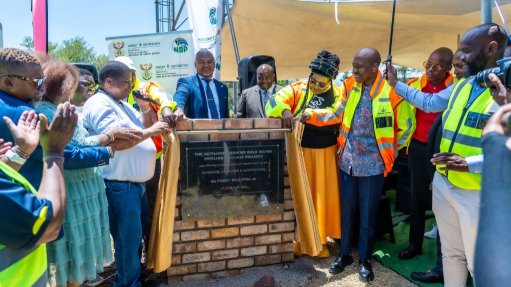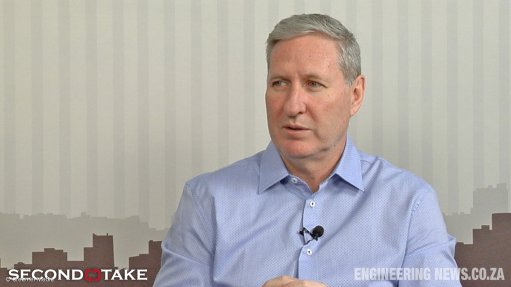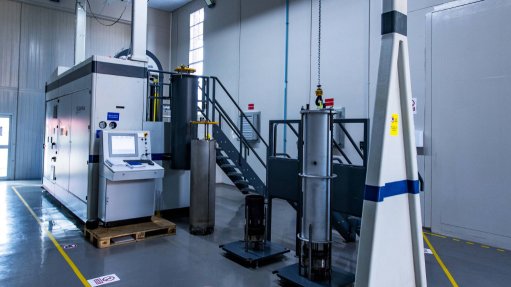South Africa positioned well to leverage the benefits of a hydrogen economy
South Africa has an ideal opportunity, and is well positioned, to leverage the potential of the emerging hydrogen economy and establish an integrated value chain.
Amid global hydrogen economy conversations, South Africa has been working to create enabling policies and create an enabling environment for a hydrogen economy to thrive, Creamer Media-hosted Hydrogen Economy webinar participants heard on Wednesday.
While many challenges and barriers still remain in the long-term development of a new hydrogen-driven industry, and much more work needs to be done, the opportunity is vast, and could set South Africa apart, said Impala Platinum sustainable development executive Dr Tsakani Mthombeni, who facilitated the webinar.
The global conversations, pursuant to the Paris Agreement, estimated that hydrogen energy would account for 5% of global energy demand. That number had now been revised to about 15%, he told attendees.
In line with decarbonisation strategies, energy transitions, the need for reliable and stable energy supply and a need to stimulate economies, a number of countries have developed hydrogen strategies, including South Africa.
“We have the Hydrogen Society Roadmap, approved by Cabinet in 2021, and released through the Department of Science and Innovation in February 2022. That was then followed by the Green Hydrogen Commercialisation Strategy that was led by the Department of Trade, Industry and Competition,” said Department of Science and Innovation director of power Dr Cosmas Chiteme.
However, enabling South Africa to position itself ahead of the pack was the 2007 Hydrogen South Africa Research, Development and Innovation Strategy, which has been a key driver in setting the foundation for the development of the local hydrogen economy.
“The focus was on how can we promote local value addition and then beneficiate our platinum group metals (PGMs) resource so that we create value-added goods locally, rather than continuing the status quo of sending the PGMs elsewhere, and then buying the value-added goods back.”
“Through [this programme], we have been able to create a very healthy portfolio of IP along the hydrogen and fuel cell value chain, and these stem from PGM-based catalysts all the way up to value-added products, such as membrane electrode assemblies, catalyst-coated membranes, as well as hydrogen storage technologies based on metal hydride,” he explained.
Government has funded the research, development and innovation programme consistently from 2008 until now, and has extended the programme by another 10 years.
“We believe that, with all that capability, we have set ourselves up to be a very significant player within the global hydrogen economy value chain, and those technologies are now being taken to market through collaboration between government and the private sector.”
Another benefit for South Africa is that it ticks all the ‘national strength’ boxes that, globally, countries often leverage.
“Globally, countries understand their national strengths. They leverage their research and development (R&D) capacity, some leverage on their manufacturing capabilities for the technology, whereas others leverage on the natural resources that they are endowed with and some markets focus on the consumption side,” said Mthombeni.
Chiteme added that, in terms of the industrial and manufacturing capability, the R&D capability, as well as the natural resource endowment, South Africa was privileged in that it could actually tick all three boxes, with capabilities in all those areas.
“I think, as a country, and in fact, as an SADC region, we are very blessed with the critical minerals that are required in the energy transition, whether it is the hydrogen economy or the mobility in terms of battery electric vehicles. We just need to get on with it and make sure that we really leverage that resource endowment to promote industrialisation in the region through this new energy initiatives.”
Development Bank of Southern Africa chief economist Zeph Nhleko points to clear opportunities for the country to “tap into”.
“One of them is the fact that industrialisation is back, and this time around, it is green.”
There is a need to ensure that South Africa’s critical minerals are leveraged to push green industrialisation and ensure that the mining, construction, engineering and manufacturing sectors, besides others across the value chain, all benefit from this process.
While there is clear policy direction and government support, there is a need to create an enabling environment for projects to now be executed, and there are a number of initiatives under way toward that.
Mthombeni noted that, what had been seen with other technologies, was that very strong, consistent and predictable policies had led to significant breakthroughs in markets that otherwise would have developed slowly.
“A case in point will be the public procurement rounds of renewable energy from independent power producers, which has played a catalytic role in South Africa, leveraging renewable-energy technologies and the market and skills.”
“I feel the conversation on hydrogen economy is more or less where the renewable-energy conversation was in the early 2000s, so there are still a few critical roles that development finance institutions (DFIs) should play at this early execution stage,” Nhleko commented.
The “obvious role” for DFIs in developing the hydrogen economy is the financing of hydrogen projects, with more than 530 DFIs globally, with an asset base of around $23-trillion. South Africa has about 45 DFIs and development finance agencies, with an asset base of about $346-billion to leverage to finance and develop this sector.
In line with this, and the critical need to develop the underlying hydrogen infrastructure key for the industry to thrive, the DBSA established a hydrogen funding platform in 2023 for South Africa.
“There are funds that could be allocated from the fiscus and probably from the DFIs, but that will not be enough, so we came together with Sanlam and the Industrial Development Corporation and two companies from the Netherlands to form what we call the South African hydrogen fund. This is a platform that we hope will catalyse the attraction of investment, and also deploy funds into the development of the hydrogen economy,” Nhleko explained.
DFIs also need to continue to augment the efforts of government and the capacity of the State to ensure the integration of green hydrogen into the national energy mix and ensure regulatory and contractual frameworks and policy instruments are set up to support the development of hydrogen.
“We have seen how important this is when we were setting up the independent power producer procurement system. This is a critical, critical area.”
Another key role is project preparation and derisking of projects to enable more private-sector participation.
“At this early stage of execution, we have to make sure that we develop projects in terms of how they are properly scoped and how feasibility studies are put together to make sure that these projects are bankable".
Developing hydrogen infrastructure will also be critical to ensure that there is a successful hydrogen economy to facilitate storage, transmission and distribution, besides others.
Mitochondria Energy Systems and Robert Bosch Africa have also been working toward the development of a hydrogen economy in South Africa.
Mitochondria, which is targeting a 20%, or $40-billion, share of the $200-billion hydrogen components market by 2050, aims to become a significant player in the hydrogen economy, which Mitochondria CEO and founder Mashudu Ramano believes will be two-and-a-half times larger than South Africa’s mining industry.
“We're not talking about an insignificant participation in this emerging hydrogen story, we are talking about becoming serious players.”
In preparation to seize this opportunity, Mitochondria is establishing a Hydrogen Valley Innovation Hub in the Vaal region of Gauteng, where it will produce its own fuel cell technology and build a significant value chain.
In the North West province, the company, in partnership with Robert Bosch Africa, is developing a Platinum Innovation Hub, where the team will develop the PGM value chain.
Robert Bosch Africa sales and marketing manager Willem Foord noted that the global company, which had reviewed the entire value chain of the hydrogen economy, hd accumulatively invested €2.5-billion over many years to develop technologies and industrialise it on a large scale.
“Today, we have a really huge portfolio of hydrogen technologies on the market in many different phases of the product life cycle.”
He also highlighted its factory in Brits, in North West , which is part of the automotive hub, where the company was producing components for the local market and the export market.
The group has further embarked on ambitions of decarbonising its 280-plus factories worldwide as much as possible.
“We see the possibility to bring our hydrogen technologies and to employ the technologies into our Brits plant to the extent of having the production of hydrogen on site, compressing that hydrogen, re-electrifying for our evening cycles and, further to that, seeing what other opportunities would be available to help other industry players use hydrogen as a decarbonised fuel, as well as use it to earn green certificates . . . to become more competitive with exporting products by reducing their own carbon footprint.”
Article Enquiry
Email Article
Save Article
Feedback
To advertise email advertising@creamermedia.co.za or click here
Comments
Press Office
Announcements
What's On
Subscribe to improve your user experience...
Option 1 (equivalent of R125 a month):
Receive a weekly copy of Creamer Media's Engineering News & Mining Weekly magazine
(print copy for those in South Africa and e-magazine for those outside of South Africa)
Receive daily email newsletters
Access to full search results
Access archive of magazine back copies
Access to Projects in Progress
Access to ONE Research Report of your choice in PDF format
Option 2 (equivalent of R375 a month):
All benefits from Option 1
PLUS
Access to Creamer Media's Research Channel Africa for ALL Research Reports, in PDF format, on various industrial and mining sectors
including Electricity; Water; Energy Transition; Hydrogen; Roads, Rail and Ports; Coal; Gold; Platinum; Battery Metals; etc.
Already a subscriber?
Forgotten your password?
Receive weekly copy of Creamer Media's Engineering News & Mining Weekly magazine (print copy for those in South Africa and e-magazine for those outside of South Africa)
➕
Recieve daily email newsletters
➕
Access to full search results
➕
Access archive of magazine back copies
➕
Access to Projects in Progress
➕
Access to ONE Research Report of your choice in PDF format
RESEARCH CHANNEL AFRICA
R4500 (equivalent of R375 a month)
SUBSCRIBEAll benefits from Option 1
➕
Access to Creamer Media's Research Channel Africa for ALL Research Reports on various industrial and mining sectors, in PDF format, including on:
Electricity
➕
Water
➕
Energy Transition
➕
Hydrogen
➕
Roads, Rail and Ports
➕
Coal
➕
Gold
➕
Platinum
➕
Battery Metals
➕
etc.
Receive all benefits from Option 1 or Option 2 delivered to numerous people at your company
➕
Multiple User names and Passwords for simultaneous log-ins
➕
Intranet integration access to all in your organisation




















